Described as the celestial landscape of Da Nang, Marble Mountains is a must-visit destination for travelers exploring the city. Recognized as a national cultural heritage site, this famous gem is steeped in spiritual, artistic, and historical significance for the nation. Journeying to the Marble Mountains, tourists can revel in the mesmerizing beauty and tranquil atmosphere of nature’s marvels. Whether you’re visiting Da Nang or just a short day trip from Hoi An, the Marble Mountains are definitely a place worth visiting. Let’s explore the stunning beauty of the Marble Mountain in Da Nang in the article below from Indochinamotorcycletours.com!
Overview of Da Nang’s Marvelous Marble Mountains
Rising out of the coastal plains near Da Nang, Vietnam, the Marble Mountains is a group of five limestone and marble hills that jut dramatically skyward. Being known as Ngu Hanh Son in Vietnamese, which translates to “Five Elements Mountains,” these mystical peaks are named after the five elements of life according to ancient Vietnamese belief: Metal, Water, Wood, Fire, and Earth. Here is some geographic information about the Marble Mountains, Vietnam.
Marble Mountains Location
Nestled in the South of Da Nang, Vietnam, the Marble Mountains rise majestically from the coastal plains and hold a unique role in the region’s cultural landscape. This captivating cluster of five limestone and marble hills, is known locally as Ngu Hanh Son (“Five Elements Mountains”).
Located at 81 Huyen Tran Cong Chua, Hoa Hai Ward, Ngu Hanh Son District, Da Nang City, Marble Mountains is just 8 kilometers from the city center. This advantageous location allows tourists to easily access by taxi, mortobike or joining Central Vietnam Motorcycle Tours. As you approach, the five peaks, each named after one of the five elements (Metal, Water, Wood, Fire, and Earth), will gradually come into view, promising a unique blend of natural wonder and cultural heritage.
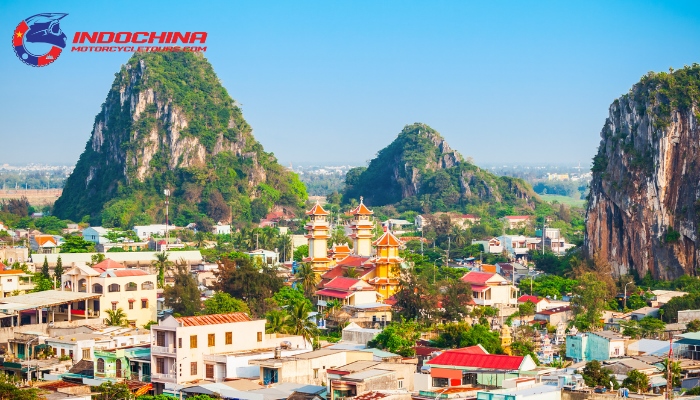
Marble Mountains is a favorite destination of tourists when arriving in Da Nang
Visitors should avoid visiting during the hottest times of the day or in the rainy season to fully enjoy the breathtaking scenery of the mountains. Also, please note that the opening hours are from 7:00 AM to 5:30 PM daily, and the Marble Mountains entrance fee costs 40,000 VND for adults, and 15.000 VND for using the lift.
Historical Narrative behind the Name “Marble Mountains”
The name “Marble Mountains” isn’t just a descriptive label; it’s a window into the region’s history and beliefs. According to Cham legend, in ancient times, an old fisherman lived on a vast sandy beach by the sea. One day, the old fisherman witnessed a giant sea dragon laying an egg. Suddenly, a golden turtle emerged, introducing itself as the divine Golden Turtle Kim Quy. The turtle dug a hole in the sand to bury the egg, and gave the man one of its claws.
With the help of the turtle’s claw, the fisherman managed to ward off hawks and other wild animals that threatened to harm the incubating egg. The egg grew larger and larger each day. Finally, one day, a beautiful young woman emerged from the egg, and the eggshell split into five pieces, transforming into five peaks of the mountain: Kim (Metal), Moc (Wood), Thuy (Water), Hoa (Fire), and Tho (Earth).
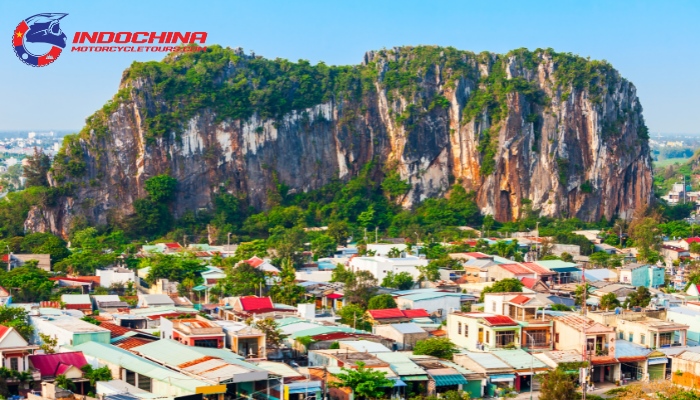
The turtle dug a hole in the sand to bury the egg, and gave the man one of its claws.
Being known as the “Five Elements Mountains,” Marble Mountains reflect the profound influence of ancient Vietnamese beliefs. The five elements – Metal, Water, Wood, Fire, and Earth – were believed to be the universe’s building blocks and played a significant role in Vietnamese culture and philosophy. Naming the mountains after these elements imbued them with a sense of cosmic importance.
Exploring the Must-See Wonders within Marble Mountains in Da Nang
Nowadays, Marble Mountains, Vietnam, is a well – known tourist destination, which offers stunning views, religious sites, historical artifacts, and natural caves to explore. Visitors can hike up the many steps to the mountaintops or take an elevator for a leisurely ascent. At the summit, you’ll be rewarded with breathtaking panoramic views of Da Nang, the surrounding countryside, and the East Sea. Here are some must-see wonders within the Marble Mountains that visitors must give a try!
Linh Ung Pagoda
Nestled on the Eastern slopes of Water Mountain, Linh Ung Pagoda is the most scenic peak of the Marble Mountains and a must-visit for travelers to Da Nang. This historic pagoda was constructed in the early 1800s, boasts a rich history and spiritual significance. Originally named Ung Chan, it was renamed Linh Ung Pagoda in 1841 and has undergone numerous restorations.
When visiting Linh Ung Pagoda, visitors will be drawn to its peaceful atmosphere, intricate Vietnamese architecture, and breathtaking views overlooking Non-Nuoc Beach. Moreover, the pagoda houses the tallest Lady Buddha statue in Southeast Asia.
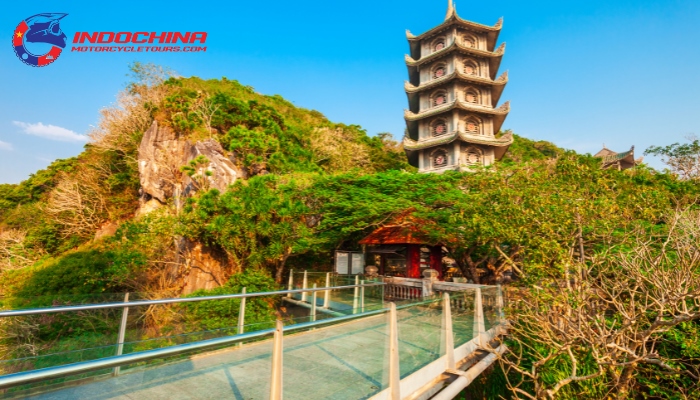
Linh Ung Pagoda – The iconic pagoda of the Marble Mountains
The Enigmatic Five Marble Mountains
The Marble Mountains, also known as Ngu Hanh Son in Vietnamese, is a cluster of five limestone and marble hills located in Ngu Hanh Son district. The five mountains are named after the five elements of Metal, Water, Wood, Fire and Earth:
- Kim Son (Metal Mountain)
- Thuy Son (Water Mountain) – the largest of the five mountains
- Moc Son (Wood Mountain)
- Hoa Son (Fire Mountain)
- Tho Son (Earth Mountain)
The Marble Mountains are home to several Buddhist and Hindu grottoes, including the Am Phu Cave (Hell Cave) and the Huyen Khong Cave. They offer stunning panoramic views of the surrounding area, including the East Sea (South China Sea) and the Non Nuoc Beach. Visitors can climb the mountains via stairs or walking paths to reach the various caves, pagodas, and viewpoints.
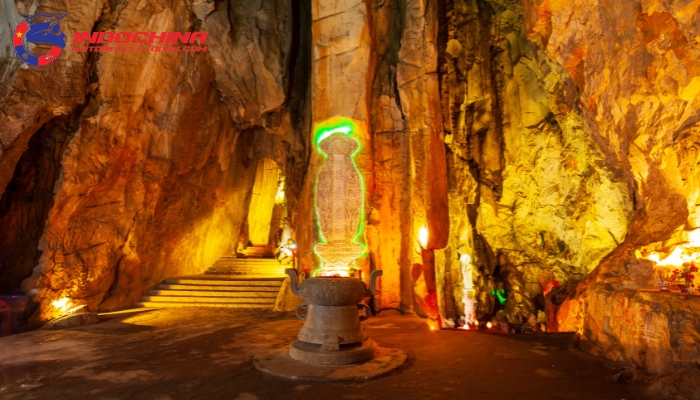
Scenery inside one of the mountains of the Marble Mountains complex
Discovery of Huyen Khong Cave
Huyen Khong Cave is a beautiful and spiritual cave located in the Marble Mountains complex. It is one of the most popular tourist attractions in the city, and has been featured in a number of films and television shows. Moreover, the cave is home to a number of impressive Buddhist statues, carvings, and stunning views of the surrounding area.
About its history, The Huyen Khong Cave was first discovered in the 18th century by a Buddhist monk named Tran Hung Dao. The monk was said to have been meditating in the cave when he was visited by a vision of the Buddha. He then decided to build a temple in the cave, which he named Huyen Khong Cave after the vision.
Nowadays, visitors to the Huyen Khong Cave can explore the cave’s chambers and passageways, admire the Buddhist statues, and take in the stunning views of the area. The cave is also a home to a number of bats, which can be seen flying around in the darkness.
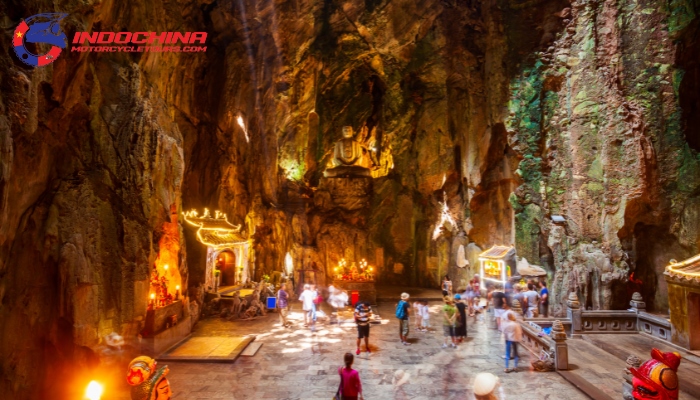
Huyen Khong Cave is the most popular tourist attractions in the Marble Mountains
Journey into Am Phu Cave
Stretching out to 300 meters, Am Phu Cave is the longest cave in Da Nang. It is located at the foot of Thuy Son (Water Mountain), the largest of the Marble Mountains. The name Am Phu, meaning “hell” in Vietnamese, was given to the cave by Minh Mang King in the 19th century. The king supposedly believed that the cave led to the sea, which was traditionally seen as the underworld in Vietnamese culture.
Inside the cave, there are many chambers filled with statues and religious icons depicting scenes from Buddhist hell. These statues depict sinners being punished for their crimes in the afterlife. The purpose of these depictions is to serve as a moral lesson to visitors, reminding them to live good and virtuous lives. Today, Am Phu Cave is one of the most famous caves of the Marble Mountains scenic complex, as well as the most popular tourist destination for visitors to walk through the cave and see many statues and religious icons.
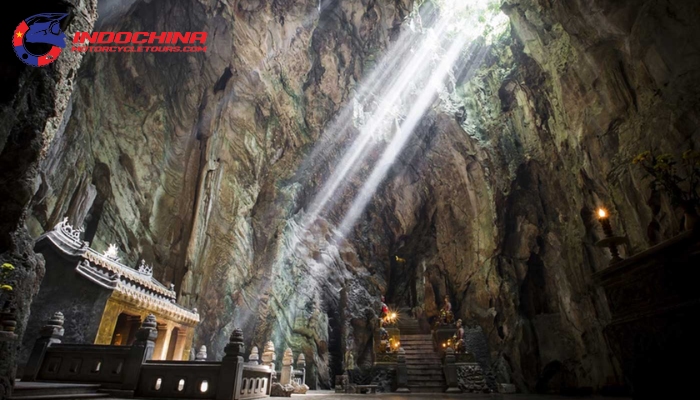
Am Phu Cave is located in Thuy Son (Water mountain)
Tranquility at Tam Thai Pagoda
The Tam Thai Pagoda is an ancient Buddhist temple and one of the oldest pagodas in Da Nang, Vietnam. Construction is estimated to have begun around 1630 during the Later Le Dynasty. Located amidst the Marble Mountains scenic area, the pagoda sits on Thuy Son (Water Mountain), the largest of the five marble peaks.
The Tam Thai Pagoda underwent renovations in the 19th century under the reign of King Minh Mang and again in the 20th century. The pagoda’s name translates to “Three-tiered Pagoda” which is reflected in its architecture. Visitors can ascend 156 steps to reach the pagoda where they will find three storeys: Thuong Thai (Upper), Trung Thai (Middle), and Ha Thai (Lower). The pagoda is known for its peaceful atmosphere and beautiful surrounding scenery.
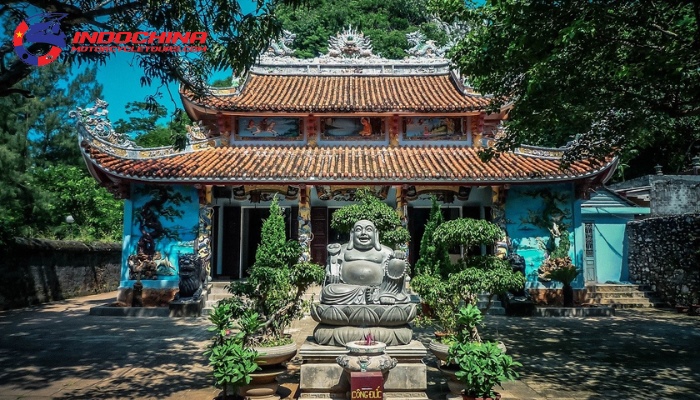
Tam Thai Pagoda is known as one of the oldest pagoda in Da Nang
Navigating the Routes: How to Reach Marble Mountains?
Since the Marble Mountains are located in Da Nang, Vietnam, you’ll need to first get yourself to Da Nang. Here are the ways to get from Ho Chi Minh City to Da Nang:
- Take a Fly: This is the fastest option, with flights taking around 2 hours and 45 minutes. There are many airlines that offer this route, so you should be able to find a good deal on a flight. Once you arrive at Da Nang International Airport (DAD), you can take a taxi or ride-sharing service to the Marble Mountains. The ride takes about 30 minutes and costs around VND 300,000 (US$13).
- Take a Train: The train journey from Ho Chi Minh City to Da Nang takes around 16 to 17 hours. This can be a great way to see the Vietnamese countryside, but it is not the most comfortable option. Once you arrive in Da Nang, you can take a taxi or ride-sharing service to the Marble Mountains, just like you would if you were flying in.

Breathtaking scenery when you get on the train from Ho Chi Minh city to Da Nang
- Take a Bus: The bus from Ho Chi Minh City to Da Nang usually takes around 20 to 22 hours. This is the least expensive option, but it is also the slowest. There are many different bus companies that offer this route, so you should be able to find a bus that fits your budget. Once you arrive in Da Nang, you can take a taxi or ride-sharing service to the Marble Mountains.
Once you’re in Da Nang, you can get to the Marble Mountains by:
- Taxi or ride-sharing service: This is the most convenient option, but it can also be the most expensive. The ride takes about 30 minutes and costs around VND 300,000 (US$13).
- Local bus: This is a more budget-friendly option, but it can be slower and more crowded than a taxi or ride-sharing service. You can take bus number 1 from Da Nang Railway Station to the foot of the Marble Mountains. The ride takes about 45 minutes and costs around VND 15,000 (US$0.70).
- Motorbike: If you are comfortable riding a motorbike, you can rent one in Da Nang and ride it to the Marble Mountains. This is a great way to see the sights at your own pace, but it is important to be aware of traffic conditions in Vietnam.

Rent a motorbike to travel around is the best option if you’re an motorcycle enthusiasts
Read more: Top 10 Vietnam Motorbike Routes That You Should Explore In 2024
Essential Guidelines for Your Marble Mountains Visit
Here are some essential guidelines for your Marble Mountains visit to ensure a respectful, enjoyable, and safe experience:
Before your visit
- Plan your visit during the dry season: The Marble Mountains are open year-round, but the best time to visit is during the dry season, which runs from November to April. During this time, you can expect sunny skies and little rain. Avoid the rainy season (from September to November) as the stairs can get slippery and some caves may be flooded.
- Wear appropriate clothing and shoes: Since you’ll be climbing stairs and exploring caves, it’s best to wear comfortable, closed-toe shoes with good grip. Opt for lightweight, breathable clothing that covers your shoulders and knees out of respect for the religious sites.
- Don’t forget your water and snacks: There are a few vendors selling refreshments at the base of the mountains, but it’s a good idea to bring your own water bottle and snacks, especially if you plan on spending a few hours exploring.
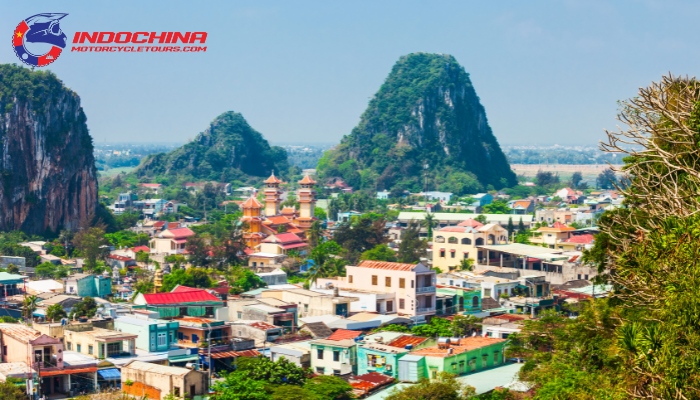
Dry season is the best time to visit Marble Mountains, which is from November to April
During your visit
- Respect the dress code: As the Marble Mountains are a religious site, it’s important to dress modestly. Avoid wearing sleeveless shirts, shorts that rise above the knee, or revealing clothing.
- Be mindful of your noise levels: The Marble Mountains are a place of peace and tranquility. Keep your noise levels down and avoid shouting or loud talking, especially near the pagodas and caves.
- Be cautious on the stairs: There are many stairs leading up to the caves and pagodas on the Marble Mountains. Take your time and be careful, especially on the steeper sections. The handrails may not always be reliable.
- Protect the environment: The Marble Mountains are a natural beauty spot. Help to preserve it by not littering and by following the designated walking paths.
- Purchase your entrance ticket: The Marble Mountains entrance fee costs 40.000 VND. By buying the ticket, you’re contributing to maintain the site and preserve it for future generations.
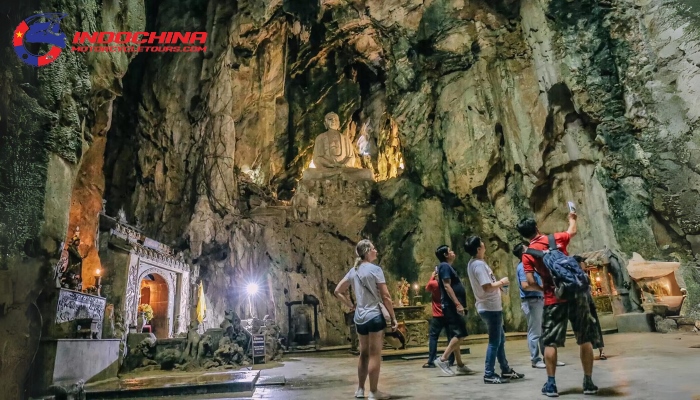
As Marble Mountains is a spiritual place, visitors should dress appropriately
Additional tips
- Hire a guide: If you want to learn more about the history and culture of the Marble Mountains, consider hiring a local guide.
- Bargain for souvenirs: If you plan on buying souvenirs from the vendors at the base of the mountains, be prepared to bargain for the best price.
By following these essential guidelines, you can ensure that you have a safe, enjoyable, and respectful visit to the Marble Mountains.
Timeline for your trip when visiting the Marble Mountains
|
Time |
Program |
|
15:30
17:00
21:00 |
A VietNam TravelMart representative will meet you at the designated location. En route to Hoi An, we’ll stop at Ngu Hanh Son, also known as Marble Mountain. This site comprises five peaks, each named after an element: Iron, Wood, Water, Fire, and Earth, reflecting Asian cultural beliefs. You’ll explore captivating caves and experience the spiritual ambiance of Buddhist temples, including Tam Thai and Linh Ung Pagodas. At the mountain’s base in Non Nuoc village, you’ll have the opportunity to admire intricate stone carvings crafted by local artisans. Journey to Hoi An Ancient Town for an evening meal featuring distinctive local specialties such as Cao Lau, Hoanh Thanh, Banh Bao, and Banh Vac. Explore Hoi An’s historic district, including:
Conclude with a leisurely stroll along the Hoai River, immersing yourself in Hoi An’s vibrant nightlife. Marvel at the town’s enchanting atmosphere, created by colorful lanterns adorning houses and lining streets. This serene beauty may leave you wishing your walk could last indefinitely. Return to Da Nang. End of services. Good bye & see you soon! |
Reviews of Marble Mountains in Da Nang from Fellow Travelers
Travelers visiting the Marble Mountains in Da Nang generally have positive experiences, citing the beautiful natural scenery, interesting caves and pagodas, and historical significance. Here’s a breakdown of some common insights from traveler reviews:
- Breathtaking views: Many reviewers rave about the panoramic views of Da Nang and the coastline, especially from the top of Thuy Son (Water Mountain).
- Unique caves and pagodas: Exploring the various caves, grottos, and pagodas like Linh Ung Pagoda and Tam Thai Pagoda is a highlight for many visitors. The caves offer a glimpse into the religious history and the natural beauty of the site.
- Cultural experience: Travelers appreciate the chance to experience Vietnamese culture firsthand through the pagodas and the surrounding atmosphere.
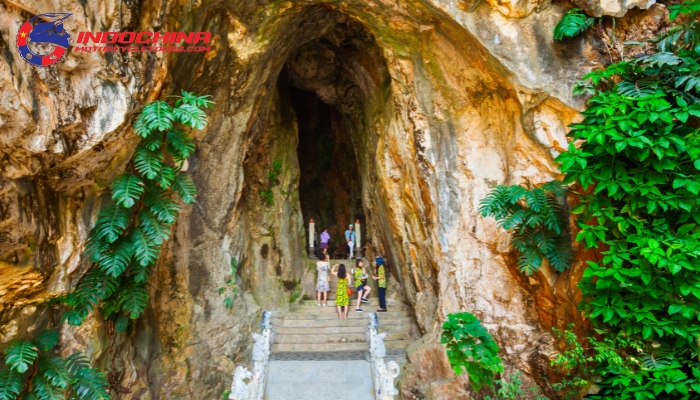
Marble Mountains is an ideal place for visitors to explore unique caves and pagodas
Things to consider
- Climbing: Be prepared for climbing stairs, especially to reach the higher viewpoints and caves. While some find it manageable exercise, others mention it can be tiring in the heat.
- Beware of touts: Some reviewers mention encountering persistent vendors selling souvenirs or offering rides. Politely decline if not interested.
- Entrance fees: There are separate entrance fees for some caves and the elevator, which some visitors find surprising. Consider purchasing a combo ticket for better value if you plan to see everything.
Overall, the Marble Mountains receive positive reviews for their natural beauty, cultural significance, and interesting sights. If you’re looking for a scenic spot with historical and religious importance, the Marble Mountains are a worthwhile destination in Da Nang. Just be prepared for some climbing and potentially some pushy vendors.
Places to visit near Marble Mountains in Da Nang
Besides the captivating Marble Mountains, Da Nang offers plenty of enticing attractions guaranteed to enrich your Vietnamese escapade. Here are some captivating places to visit near the Marble Mountains that you shouldn’t miss:
- Linh Ung Pagoda at Son Tra Peninsula: This colossal pagoda boasts the distinction of holding the tallest Lady Buddha statue in Southeast Asia, measuring a staggering 67 meters (220 feet). It’s a popular pilgrimage site and offers breathtaking views of Da Nang.
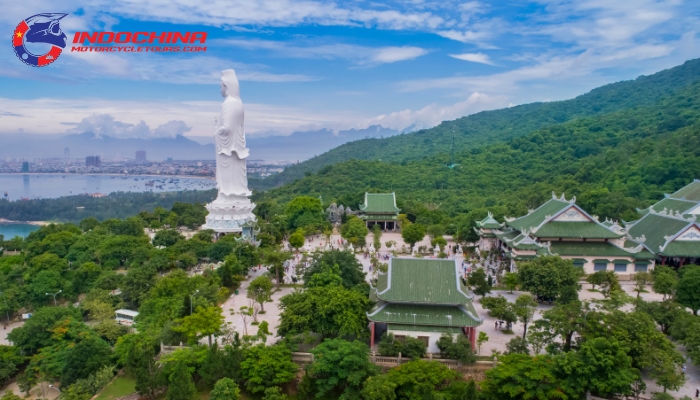
Linh Ung Pagoda at Son Tra Peninsula is famous for its giant Lady Buddha
- My Son Sanctuary: Journey back in time and explore the fascinating ruins of My Son, an UNESCO World Heritage Site. This former Hindu religious complex was once a powerful kingdom and is known for its intricate Cham architecture, including towers, temples, and sanctuaries. The sanctuary is located around 70 kilometers Southwest of Da Nang.
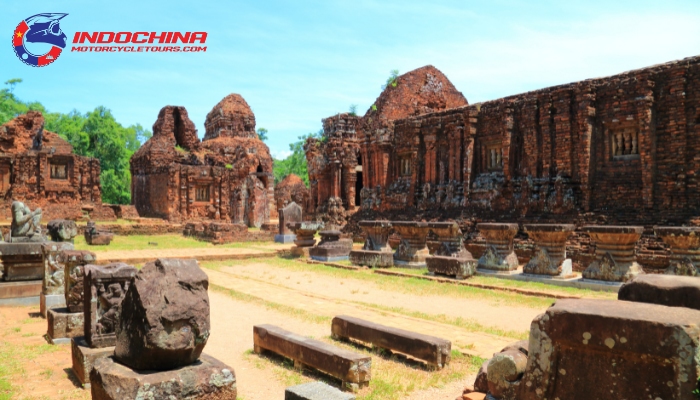
My Son Sanctuary is recognized as an UNESCO World Heritage Site
- Hoi An Ancient Town: Embark on a charming adventure through Hoi An Ancient Town, which is known as an UNESCO World Heritage Site. This well-preserved town situated approximately 30 kilometers from Da Nang is renowned for its colorful architecture, vibrant riverside setting, and its abundance of tailors, art galleries, and souvenir shops. If you’re planning to visit here, don’t miss the chance to try Hoi An’s famous “Cao Lau” (noodles with pork and rice crackers) and “Banh Mi” (Vietnamese sandwiches).
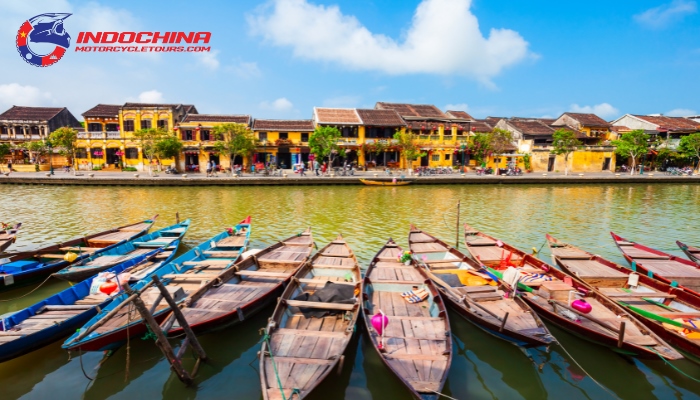
Immerse yourself in the poetic scenery of Hoi An Ancient Town
- The Cham Museum: Delve deeper into the rich heritage of the Cham people at the Cham Museum. This museum, located in Da Nang city center, houses an extensive collection of artifacts, sculptures, and recovered items from the My Son Sanctuary, providing valuable insights into the Champa kingdom’s art, culture, and religious beliefs.
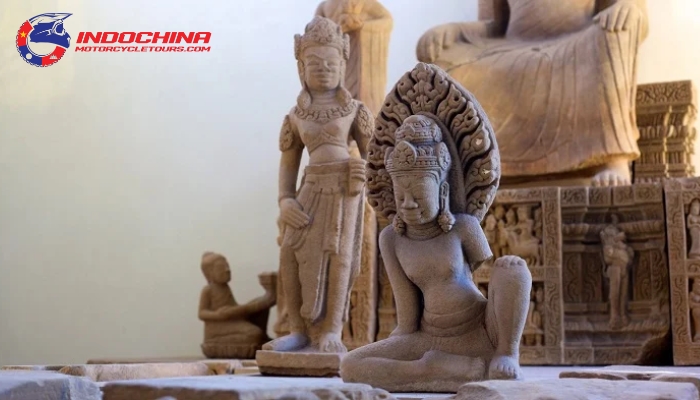
The Cham Museum – a place not to be missed if you are a lover of ancient art
- Asia Park Da Nang: Craving for amusement and thrills? Look no further than Asia Park Da Nang, the largest theme park in Vietnam. This park features exhilarating rides, water slides, a zoo, a beautiful flower garden, and a 3D museum. It’s a perfect spot for a fun-filled day with your family or friends.

Join in vibrant atmosphere in Asia Park Da Nang – The largest theme park in Vietnam
Through this article, we have just shared with you some travel experiences at Marble Mountain in Da Nang. Hopefully these pieces of advice will bring visitors useful information about this tourist destination. If you are a motorbike enthusiast and intend to visit this enchanting place, don’t hesitate to book Vietnam motorcycle tours from Indochina Adventure Tours to enjoy unforgettable experiences. Check this out today!
Read more: Top Things to Do in Da Nang: A Comprehensive Guide for Travelers









